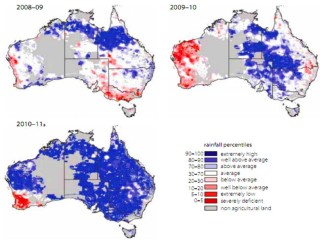 Beef producers across Australia are expected to experience improvements in farm cash incomes for the 2010-2011 financial year, according to the latest Federal Government projections.
Beef producers across Australia are expected to experience improvements in farm cash incomes for the 2010-2011 financial year, according to the latest Federal Government projections.
However, the timing of yesterday's report into the 2010-11 financial performance of Australian beef production enterprises comes with an important rider – it does not take into account the impact that the recent suspension of live exports to Indonesia is likely to have on northern producer incomes in particular.
The Australian Bureau of Agricultural and Resource Economics and Sciences' annual Australian Beef report, released yesterday, forecasts increased incomes for beef production enterprises in 2010-11 on the back of a significant improvement in seasonal conditions over the past 12 months.
Farm cash incomes for beef producers in northern Australia were forecast to increase by 54 percent on average to $60,100 per farm in 2010-2011 – but again that figure does not account for the impact of the live export ban on Indonesian market-dependent northern cattle producers.
The forecast improvement in incomes is based largely on a reduction in costs, according to the survey.
Despite higher interest rates and higher maintenance and repair costs in 2010-11, partly due to infrastructure damage caused by natural disasters such as cyclones and flooding, farm cash costs for northern producers were expected to be lower this financial year largely because of savings in the purchase of fodder and replacement cattle.
Receipts for northern producers were tipped to remain largely the same this financial year as last. While cattle prices were higher for most of this year, most producers sold less cattle to focus on herd rebuilding.
In Southern Australia improved seasonal conditions were expected to drive a 15 percent increase in average cash incomes of beef producting farms to $66,200 per farm.
Average farm receipts for southern producers were expected to be lower as producers reduced turnoff to retain stock for herd rebuilding. However, the effect of this on farm cash incomes was more than offset according to ABARES by an even larger reduction in farm cash costs.
“Well above average rainfall and abundant pasture growth are expected to result in much lower expenditure on fodder while purchases of beef cattle are also expected to be reduced due to limited availability of stock and high saleyard prices."
The only categories of producers expected to record weaker farm cash incomes in 2010-11 were southern producers with large and very large herds, due to reductions in the number of cattle sold. However, their herd rebuilding activities were expected to pay dividends as increased cattle numbers raised the value of their farm inventories over the next 12 months.
The retention of cattle due to improved seasonal conditions and increases in the number of cows mated was expected to result in an increase in the number of calves branded across Australia in 2010-11 compared to the previous year.
